The mighty tread of adamantium feet heralds another Narrative Play article on the new Imperial Knights Codex by Adam from Masters of the Forge!
The proverb “They shall beat their swords into ploughshares” would probably not only be lost on the noble people of the Imperium of Man, but it’s possible that repeating such a thing would be considered some kind of thought crime punishable by flogging. There are few things in the galaxy which could be considered more anathema to this saying than the Imperial Knight, for in the time of the Dark Imperium, the wolf has come to dwell with the lamb. But the lamb is packin’.
Indomitable Spirit
The tale of the Imperial Knights is fascinating. These huge, self-contained power suits were used throughout the golden age of technology for the exploration and exploitation of habitable worlds. There was no terrain nor natural threat that the Knight suit could not overcome. Some of the more dangerous or inhospitable colonies relied heavily on their Knight suits for both their utility and strength of arms. Even when all other STC machines failed, these worlds would still maintain the STCs responsible for keeping their Knights on-line.
In time, whether due to the natural predilections of the pilots, the nature of the Knights’ machine spirits, or a little of both, the Knight pilots grew a somewhat archaic worldview. They became monarchs on worlds that worshipped them as heroes. It was only a short time before these Knight pilots ruled in totality and their ritualistic traditions of chivalry and nobility had permeated their societies.
The conservative Knight Worlds slowly turned their backs on any technology which did not serve the Knights themselves. More importantly, they also mistrusted those who began to show a powerful connection to the Warp. Some worlds even burned these psykers as witches. As such, when all other human colonies were thrown into crisis by rebellious artificial intelligence and malevolent psychic threats, the Knight Houses weathered the Old Night better than most.
As the Maelstrom abated, the burgeoning Imperium and the Mechanicum reached out through the stars in search of worlds to annex. Although the Mechanicum had a head start, many noble Knight Houses aligned themselves with either faction. It was difficult to deny the technological prowess the Mechanicum could offer. It was equally difficult to deny the might and nobility of the Emperor of Mankind. Over the years, the Knight Houses swore oaths of allegiance to the various factions within the burgeoning Imperium. As such, when the Horus Heresy swept through the galaxy, the Knight Houses could not deny their destiny to engage in the war. Which side was in the right did not matter. All that mattered was that their oaths would be fulfilled.
When you are developing your own army’s background, keep these details in your thoughts. This is true whether you’re using an established Knight House or one of your own. What was their genesis? How did they ride out the Old Night? What factions did they first encounter when the Maelstrom abated? What were the consequences, good or ill, of these encounters?
A Mighty Bulwark
The surviving Knight Houses remain in the service of the Imperium today whether they are of the independent Questor Imperialis worlds or the Questor Mechanicus who are each aligned with a various Forge Worlds. Regardless of whether they bear the Aquila or the Cog, the hallmarks of Knight Worlds are a stoic martial tradition of nobility and personal sacrifice.
Whether you’re building your own Knight House or using one from the established lore, how your House manifests its noble purpose is of utmost importance. Is the lineage by blood? What are the particulars of that succession? Are noble ranks attainable through personal combat? Perhaps resources are low and tests other than knightly combat are used to determine one’s dominance over their peers.
Like Space Marine Chapters, there are many different ways that Knight Houses determine a noble’s fitness for duty. Of course, intensive training and schooling are of utmost importance. Duels are certainly a tradition on many Knight Worlds. Some Knight Houses even put their pilots through intense hunting rituals where the young nobles must kill dangerous mega-fauna to prove their quality. Whatever the case, a young noble’s training isn’t limited to the school-room or the battlefield. They must also stalk the dangerous battlefield of royal court where they learn to maneuver and attack in totally different ways.
Of interesting note is that, in the past, the lore implied that the first male successor of a family were often chosen as Knight pilots. There was a quiet (and quite possibly unwitting) rebellion against this in other media such as the novels and video games where women featured prominently. Now, the lore in this Codex speaks to a variety of ways in which pilots are chosen. Of course, individual players are welcome to set up any rules of succession they desire for their House, but there is no all-encompassing guidelines regarding who has first crack at a vacant Throne Mechamicum.
I strongly recommend you look through each of the Houses represented on the color plates within the Imperial Knights Codex. Do this even if you’ve already made up your mind to build your own. The histories and traditions of these factions will help give you ideas to craft your own story.
Starting Your Army
You can build your Imperial Knights army in three ways. Each method contains three key factors: lore, traditions, and models.
If you put lore first, then you either have an idea in mind or a specific House in mind. This will directly inform you on which Tradition you will use. Once you do this, you can decide which models best fit that Tradition.
Alternatively, you may prefer to use a specific play style with your Knights. In this case, find a tradition that best fits your style. After you do that, you can decide whether to use the paint scheme of that House, or create your own unique House that simply uses the same tactics. Again, model choice should naturally fall into place with this method.
The third way to start your army is Hobby First. You might simply really like the paint scheme of a specific House, lore and play style be damned. There’s nothing wrong with this, though it is the riskiest method of collecting an army. Having said that, sometimes there can be a great deal of fun in learning to use an army that you’re totally unfamiliar with. Don’t worry about getting bored with a scheme, though. There’s nothing stopping you from taking a break and painting up a Freeblade to join your host into battle.
I must admit that, when I started my army, I simply bought whatever I thought looked cool and went from there. My Knight House’s narrative developed later. If you’re feeling similarly torn on your story, I suggest magnetising your models so that you can solidify each Knight’s story at a later date.
In truth, there is no wrong answer here. Simply follow your instincts and have fun with it.
The Legend of Your Knight House
However you come to it, you’ll eventually have to either come up with a backstory for your House or read up on the one you have chosen. The narratives your weave with your Imperial Knights, as with any army, must be informed by two things: the purpose of the army in battle within the Warhammer lore and the theme of your army specifically. The latter is entirely up to you.
For example, my Questor Imperialis army, Knight House Draco, works at the behest of the Ordo Malleus and is tasked with hunting down and destroying macro-threats of a Daemonic nature. Clearly, this will have an impact on my narrative choices. Who are your Knight House’s legendary foes?
Don’t forget that Imperial Knight Houses, as much as they hold long grudges, also have a tendency to form oathsworn bonds of friendship with other factions such as a Forge World or Astra Militarum Regiment. With whom does your army fight on a regular basis? Is it an army you already own? You could also work with one of your real-life gaming friends to create an allied bond with one of their armies. In either case, think about the the particulars of the relationship and the events that led up to it. Indeed, you could even play out those events in a campaign.
If you have not yet chosen a Tradition, now is the time to do so. This should be easier now that you are armed with the knowledge of your army’s history in battle and theme. Don’t just look at the Tradition itself when choosing abilities for your custom House. Also have a look at the Stratagems (both House-specific and generic). They might help you narrow down your theme.
For Knight House Draco, I have chosen House Griffith’s Tradition, “Glory of the Charge”. This allows them to use Glorious Intervention even if they aren’t a Character and gives them +1 attack on the charge. I tend to use a lot of Knight Gallants in my army lists and my pilots are known for their hot-headed lust for battle. This is not surprising considering the foes they must fight. I could have also chosen House Mortan or House Taranis, but I felt that the House Griffith Stratagem, “Dragonslayer”, best fit my army’s theme, granting me a +1 to wound rolls versus threats with 10 or more wounds. I also have a feeling my three Knight Gallants will be using the “Full Tilt” stratagem quite often, allowing them to charge even after they have advanced.
For another example, I’d imagine a Questor Imperialis House that fights Tyranids or Orks all the time might pick House Cadmus, whose Tradition gives them re-rolls to wound models with 12 or fewer wounds and a Stratagem called “Bio-Scryer Cogitator Array” that allows them to shoot out of sequence at a unit that arrives on the battlefield as reinforcements. Of course, this army will also likely make liberal use of the “Chainsweep” stratagem that deals mortal wounds to enemy models within 3” on a 6+.
Do note that, although you may feel compelled to choose a Questor Imperialis Tradition for your Questor Mechanics army or vice-versa, you may want to reconsider. All of the Stratagems, Warlord Traits, and Heirlooms (relics) are themed quite specifically for each paradigm. If it were me, it would feel quite out of place for my High Queen to be armed with the Cawl’s Wrath relic.
No matter what theme you’re going for, do consider picking up either a Knight Castellan or a Knight Valiant, whichever best fits the theme and fighting style of your House. They can make for an impressive centerpiece and tactical anchor for your army. With one Knight per Detachment selected to be a Character in your army and the inclusion of multiple Warlord Traits and Relics, there are more ways than ever to customise your Knights and really make them your own. Be sure to have a look at the Relics before you build your next model; maybe there’s something you’d like to kitbash.
The Cerastus Problem
The Cerastus Knights are not really acknowledged by the new Codex, so you’ll have to work with your narrative gaming partner in order to fully incorporate them into your games. Of course, there is no real recourse for Matched Play until Forge World releases some kind of update and Robin Cruddace did mention on Warhammer TV that they were aware of the issue and would remedy it soon.
For now, my suggestion is as follows:
- Wherever the text indicates a rule affects a Questoris class Knight, I would assume it also applies to your Cerastus Knight. For example, your Cerastus Knight should count towards the minimum of three models required to make you eligible for Command Benefits in a Super-heavy Detachment.
- Some Stratagems have multiple costs for different classes of Knight. In the name of fair play, always use the most expensive CP cost, even if a Questoris Knight would be cheaper.
- Obviously, in either case, whichever House you pick would determine whether it is Questor Mechanicus or Questor Imperialis.
Again, although this is common sense, be sure to check with your opponent ahead of time and also check the rules to make sure there won’t be any tricks or combos might cause your opponent to have a bad time. If you find any issues, then simply refrain from doing it in your games.
Scenarios
We don’t know what Games Workshop has in their pockets for future narrative missions, but we do have a store of old scenarios we can use to help us craft more exciting stories with our friends.
Scoring: The key important factor of crafting narrative missions with Imperial Knights is mitigating the fact that Knights are extremely weak when scoring objectives and extremely strong in most kill point situations. When crafting your missions, consider using Power Level instead of units killed in kill point missions. On the other hand, when it comes to holding Objectives, using Power Level in this case would suddenly swing the balance heavily in the favor of the Knights. Instead, consider using remaining wounds on nearby models for holding Objectives. This allows your opponent to whittle down the Knight and make it less capable of holding the Objective against your unit of infantry. It also makes some narrative sense in that a weakened machine with armour plates blasted off and malfunctioning servos would actually find it harder to hold a position than a strong, less-damaged Knight.
Old Scenarios: If you can find the old Sanctus Reach book and the old Codex or Altar of War books, they include missions that feature Imperial Knights. You don’t have to use those specific missions, of course, but it can help you craft new ones using some of the same methods. For example, breakthrough missions are naturally good with knights because they don’t usually fly or deepstrike.
Wrecked Knights: Another factor when playing narratively with Knights is the fact that they are huge vehicles. It makes little sense that they would simply disappear from the battlefield when destroyed. You can adjudicate a destroyed Knight on the battlefield in a few ways. You could go nuts and make several wreckage markers out of actual Knight kits. Alternatively, you could just make one and cast it in resin. You could just cut one out of paper, too. Of course, you could just leave the knight standing where it is and put a bunch of fire markers on it to represent the fact that it has been deactivated. You may want to come up with a way of incorporating destroyed Knights into your missions as well, perhaps as a tertiary mission objective.
Knight vs. Knight: Of course, you could forge a narrative against your friend’s Questor Traitoris army. This could be quite a fun campaign. With such a low model count on the battlefield, you might feel compelled to make up a bunch of weird narrative rules to make the combat feel more realistic. For example, in situations like this, even the dynamic initiative method of 8th edition feels a little binary: who got the charge off and who didn’t. Why not use dice rolls to determine who swings first in each combat, providing a +1 or a +2 to any knights which charged. You may also want to use older or more narrative rules such as for the Thunderstrike Gauntlet. Also, when facing off against Questor Traitoris, try opening up some of the traits and stratagems of both the Chaos Space Marines and Imperial Knights for your hated foe to use in battle.
Knight vs. ‘Naut: Remember that the Imperium aren’t the only faction to boast knight-sized models. You can create narratives against lances of Wraithknights and Ork walkers to similar effect.
Making Imperial Knight Narratives Palatable
One tough thing about setting up a narrative for your Knights is the terrible stigma this army currently suffers. This stigma is, arguably, deserved. In 6th Edition, the Imperial Knight en masse was a terror for many armies. An army of Knights was untouchable by many army builds. This is absolutely not the case in the new Warhammer 40,000, but the fear and resentment of those days remains. This can really put a damper on your narrative plans. You can really see the dubiousness in your friend’s eyes when you suggest such a thing. “Oh really?” that look says, “You want to do a narrative with your no-fun death-machines? Riiight.”
Armigers: Let there be no doubt that Armigers are still tough, little machines, but they’ll certainly seem less scary to your prospective narrative gaming partner. Although you and I both know that regular Knights aren’t so bad, the thing to remember is that perception dictates reality as much as facts do. The Armiger is being heralded as the saving grace of the faction, making the army more palatable to play against. True or not, use that to your advantage. Tell your opponent that you’ll have a lance or two of Armigers in the campaign. Certainly use them in the early stages. As the campaign progresses, you can probably omit them if you want to as your opponent realizes it isn’t so bad. What’s more, it’s possible your list will be better with the Amigers than without, though that’s a topic for a more competitively-minded columnist.
Knight Preceptor: If you do take a bunch of Armigers, it might make sense to also bring along a Preceptor to accompany them. While it is nice that they have an aura buff for the Armigers, more importantly they serve a narrative purpose as teacher and mentor for young Armiger pilots. Note that you have a Freeblade and a crusade force of Black Templars to thank for the safe return of the Las-Impulsor STC back into Imperial hands. Be sure to salute them if you see them on the battlefield.
Allies: Although we would all prefer to just play our Knights as an army, if our goal is to convince other players to accept our army in narrative games, it’s best to make those first few games as palatable as possible. Give your opponent some serfs or Skitarii to kill if you’ve got the models for it. Again, as with the Armigers, allies (particularly Astra Militarum allies) might actually make your army more powerful rather than less, so be careful with your relic and warlord trait choices. Clearly, it’s best to avoid anything that allows you to regenerate command points.
Play to the Weaknesses: In your first campaign, you might want to come up with fun rules that lampoon some of the perceived issues with Imperial Knights. For example, you could award a Traitor Astra Militarum opponent 1 Command Point (representing the cheering of the Guardsmen) every time they score an unsaved wound against a Questoris or Dominus class Knight with a lasgun.
Get Stompy
I hope that you can use the information in this article to help you craft meaningful stories with your friends whether you have a Knight army yourself or you know someone who’s always wanted to use their Knights in a narrative. It isn’t scary! It can actually be quite rewarding.
The codex itself has done a lot of good when it comes to solidifying the Imperial Knight’s place in the Warhammer zeitgeist. Believe it or not, the Imperial Knight is here to stay. My advice is to embrace it and enjoy it.
Do you have anything to add to the conversation? Have you had luck convincing your friends to join you in an Imperial Knights narrative? Please leave a comment below.
Did you like this content? Perhaps you’d be interested in more narrative topics. Check out the Masters of the Forge podcast. Episode 114 featured an interview with David Annandale about his Castellan Crowe series. We also have a podcast on the Freebooter’s Network called Altar of War where we play a Narrative game and record a battle report as the game is played. Episode 9 featured the Kroot and Drukhari in a battle over some Malan’ti Wraithbone.
And remember, Frontline Gaming sells gaming products at a discount, every day in their webcart!

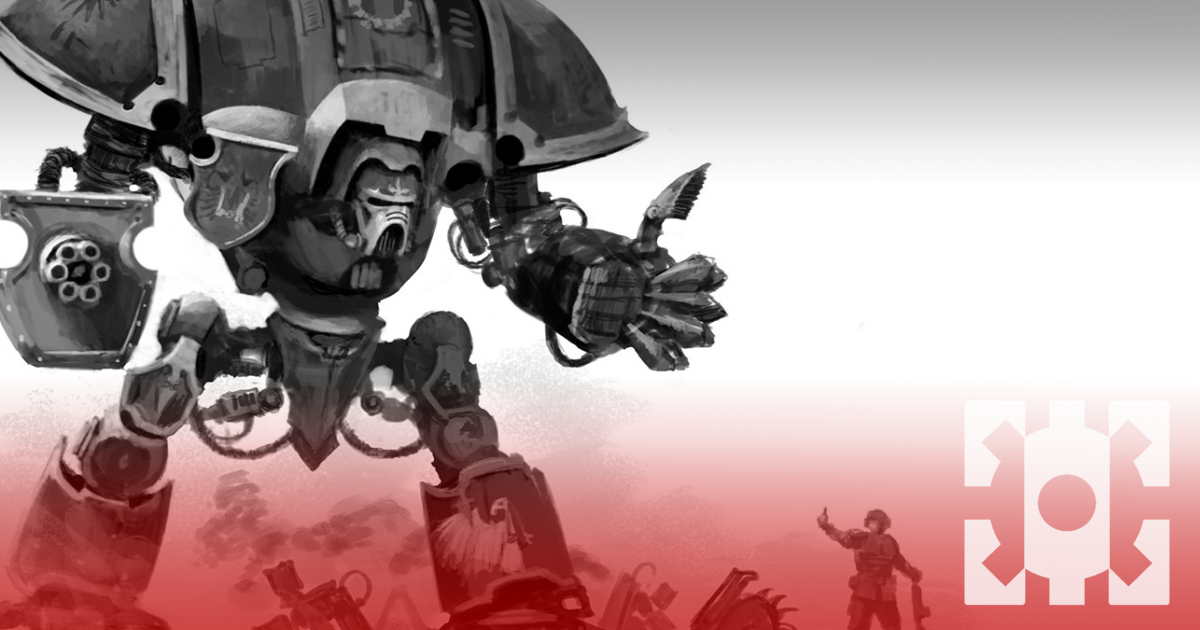
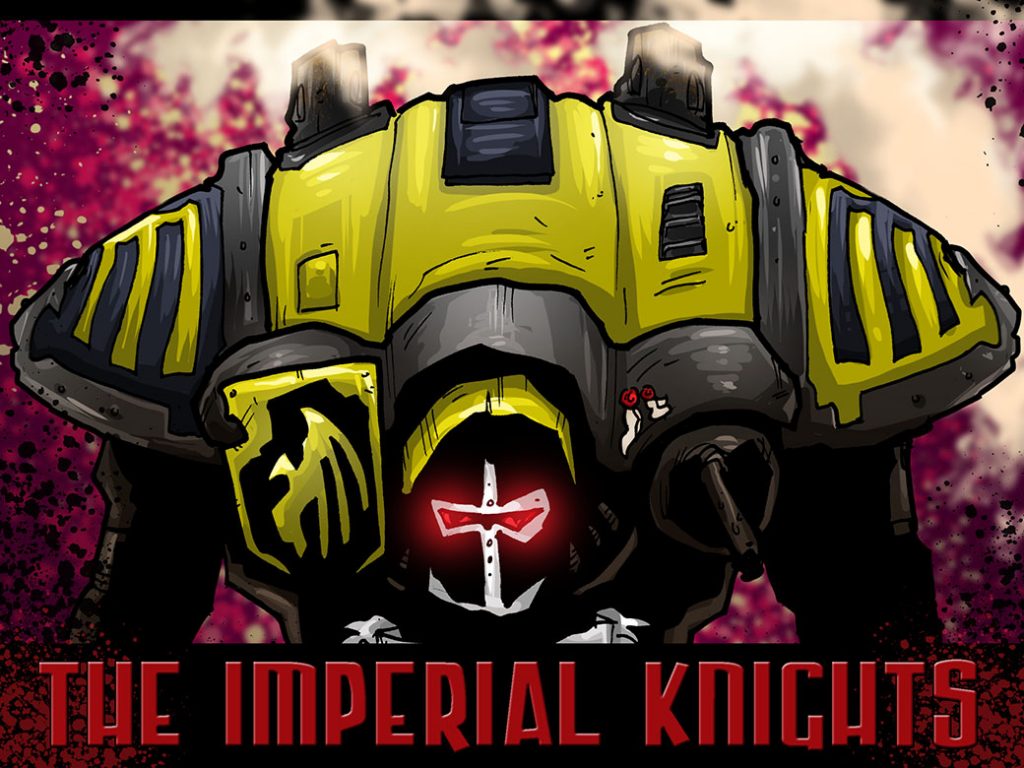
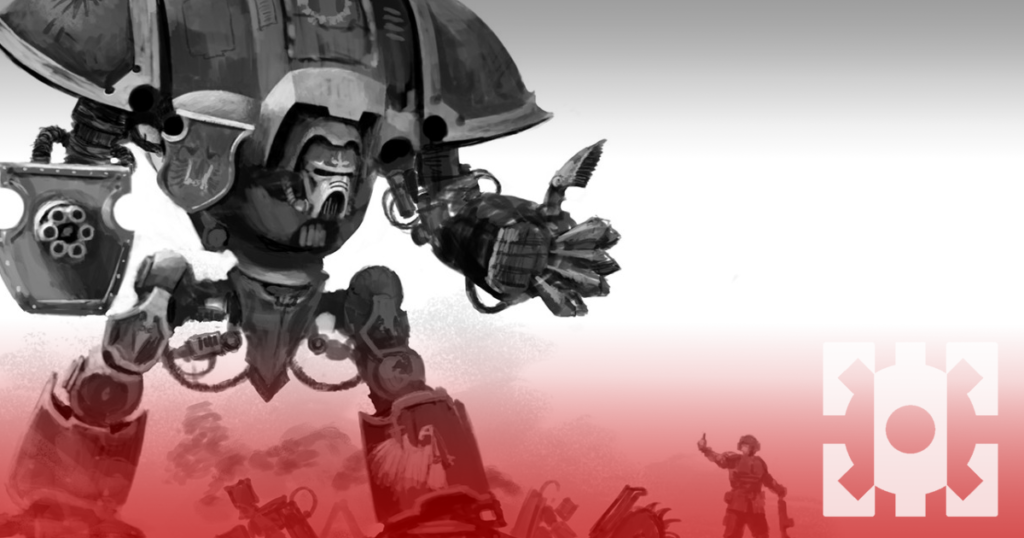
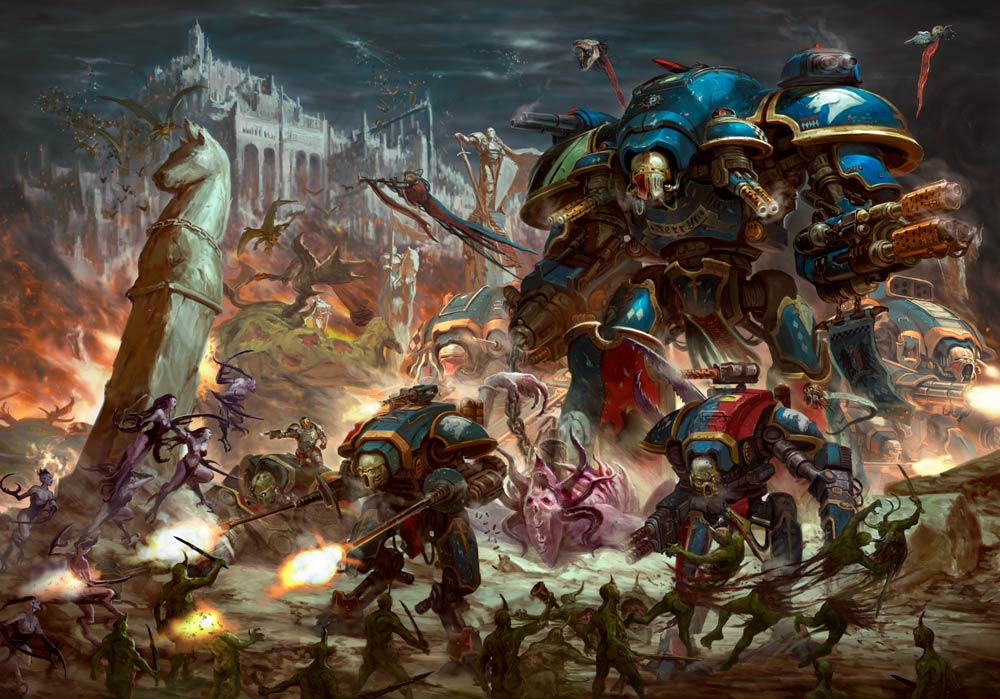
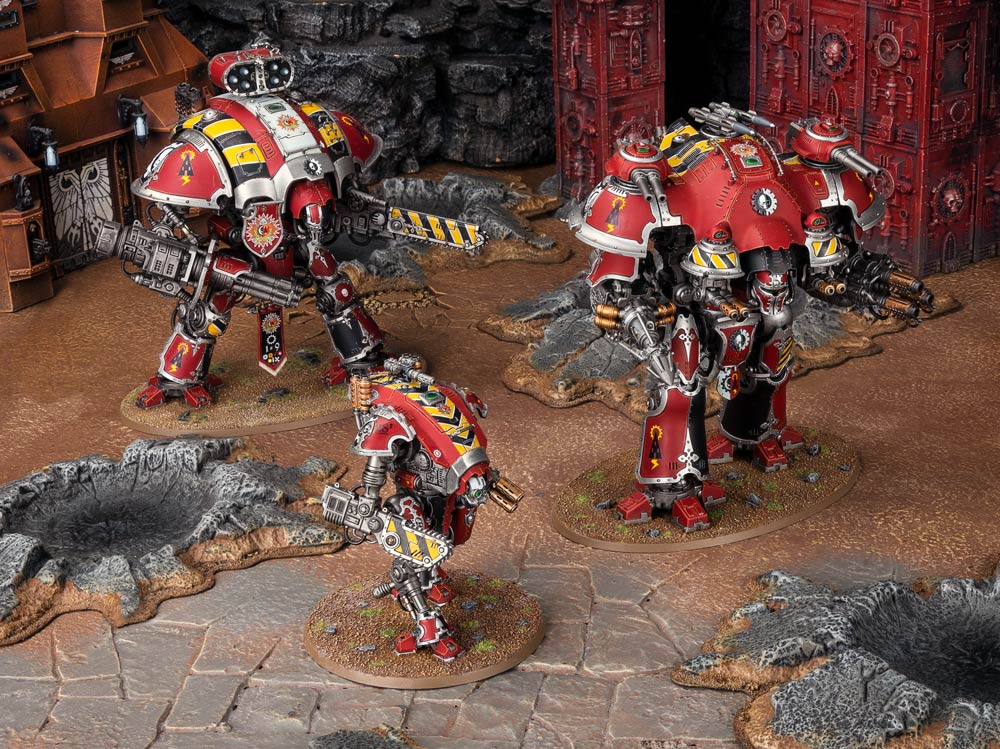
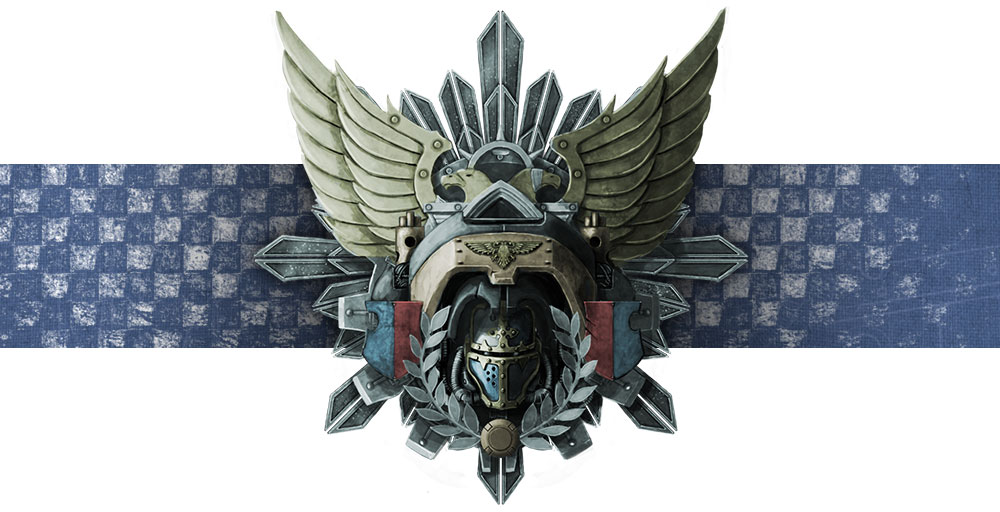
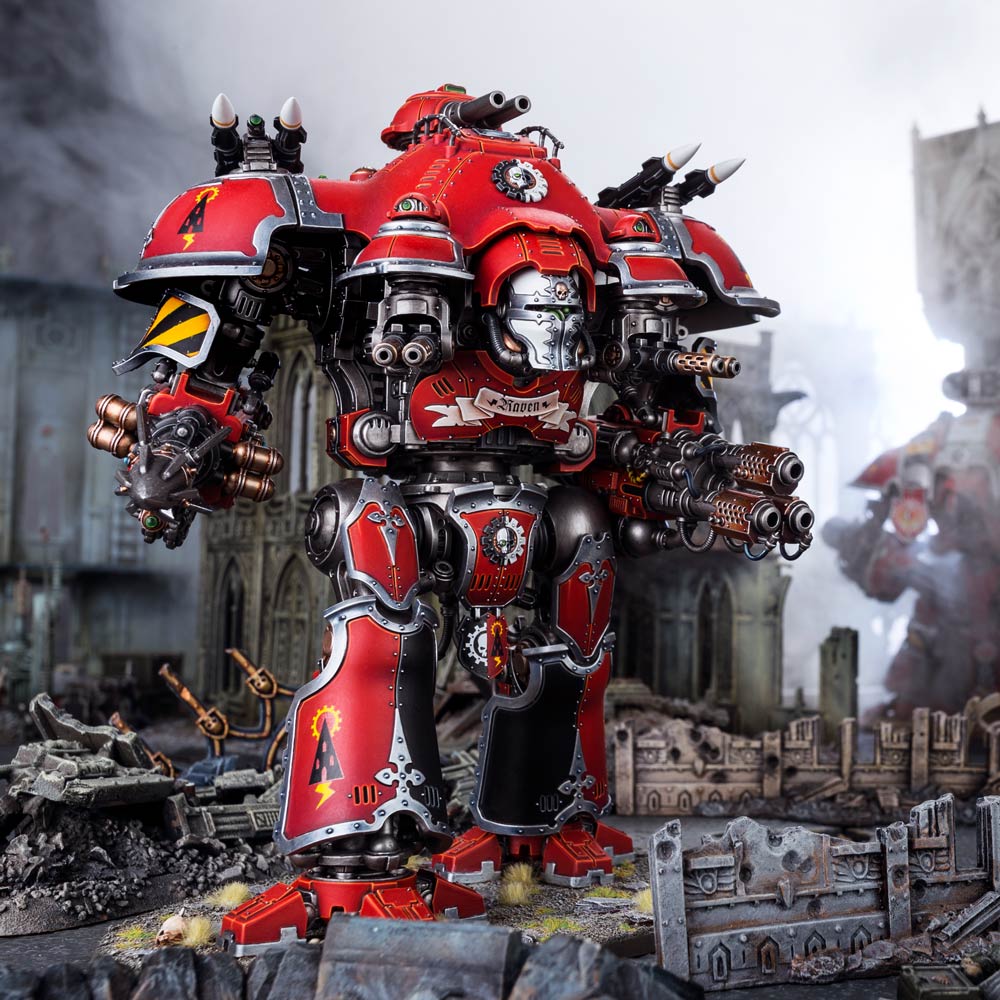
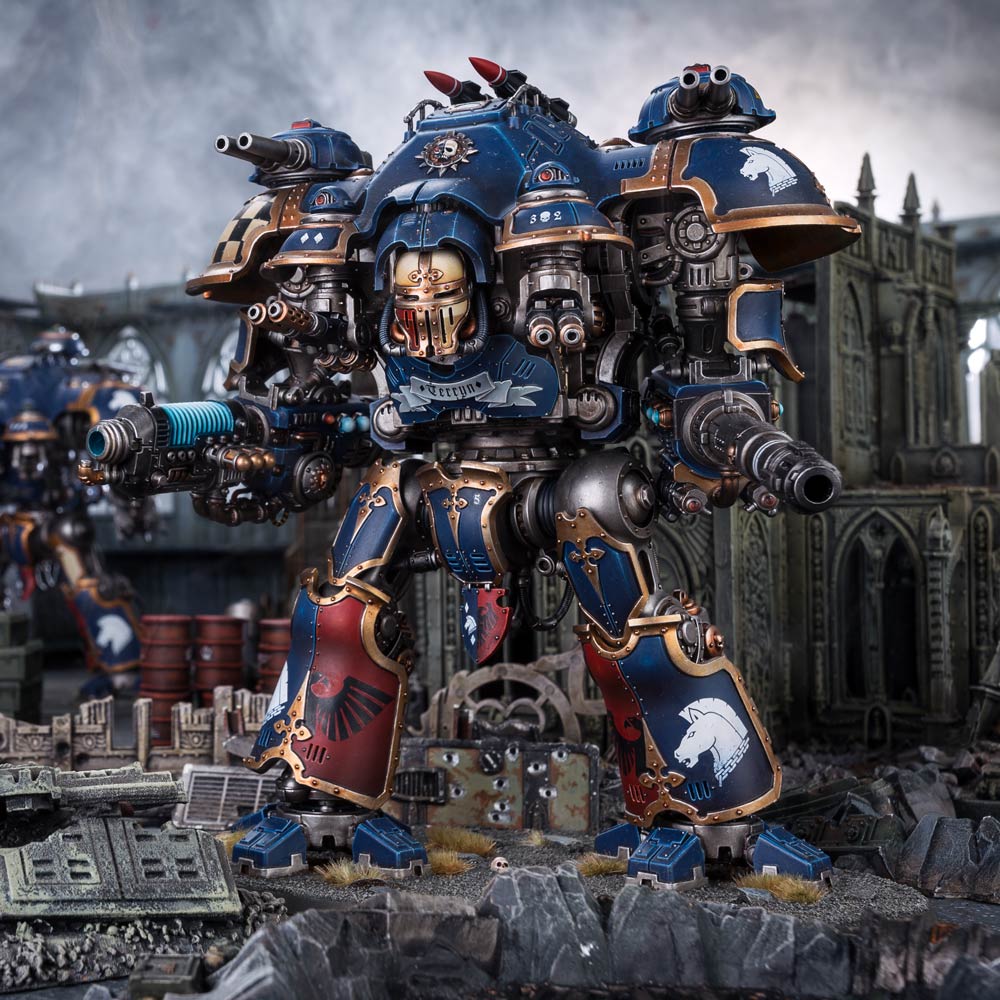
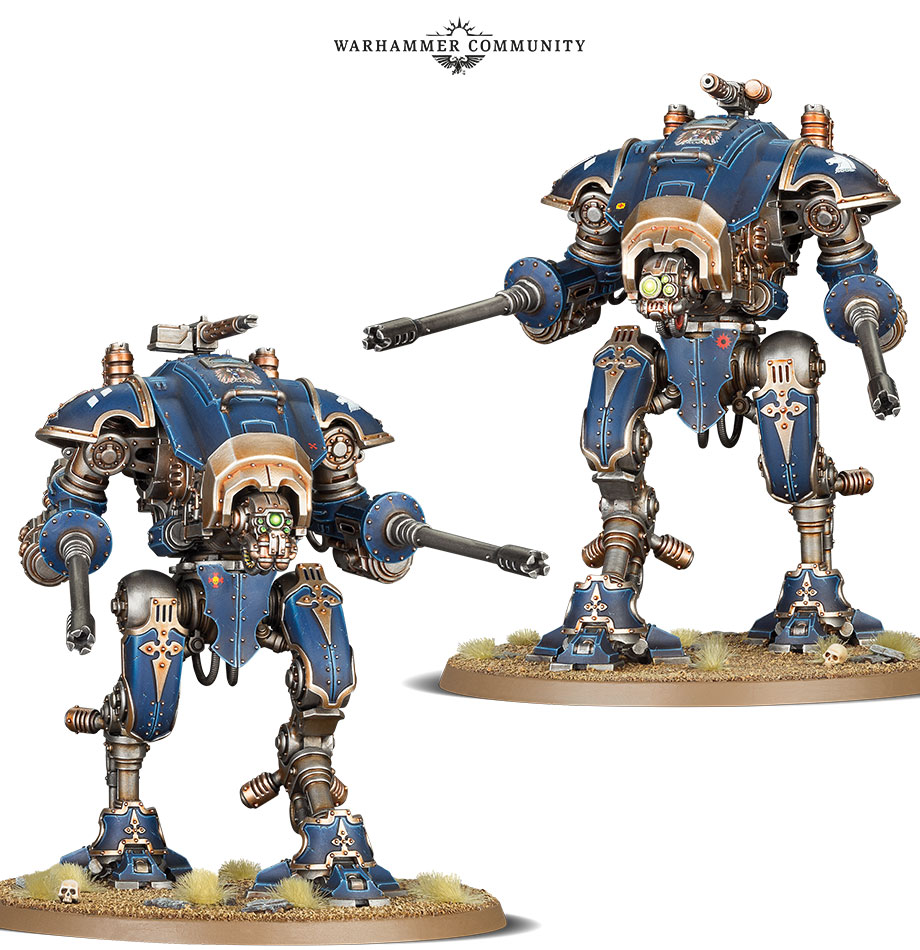
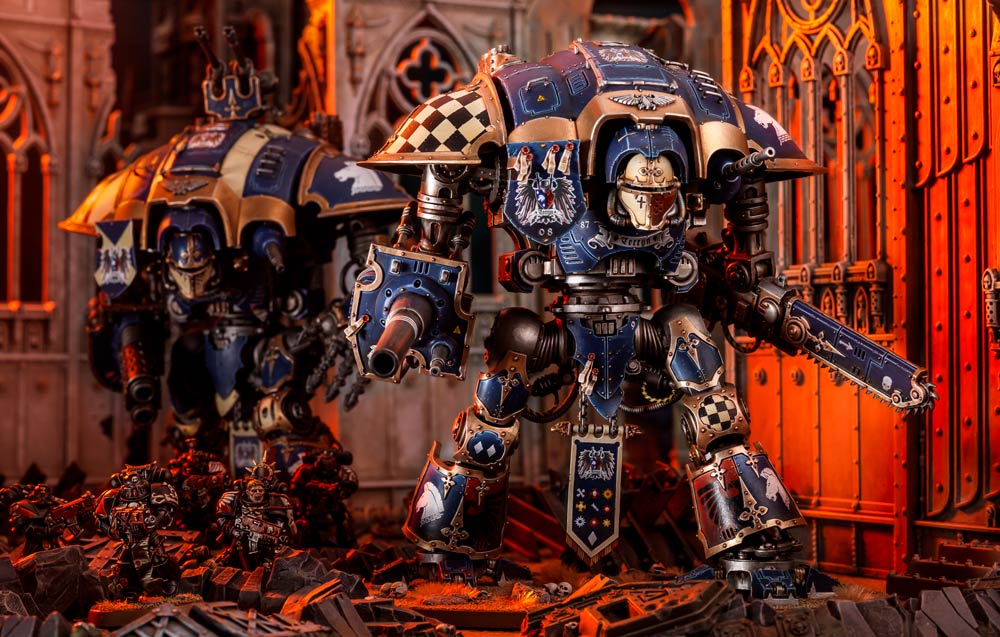


Heh. I haven’t read the new Dex yet, but I wouldn’t be surprised if some of the Knight Worlds at some point ended up more or less literally beating their plowshares into swords.
On the topic of Knight wreckage: It’s fairly common for Players to magnetize or otherwise make their Knights separable at the waist, both for ease of transportation and because it looks cool when it can torso twist. In that case, separating the two halves and then adding some fire/smoke effects can make for a really great-looking wreck.
Awesome tip!